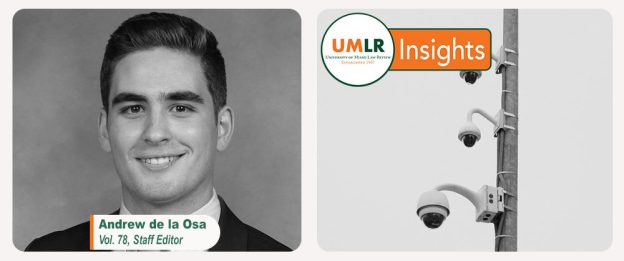ANDREW DE LA OSA—Ever since the Supreme Court’s landmark decision in Carpenter v. United States courts continually wrestle with the issue of emerging technology and the increased capabilities that it provides to police departments, often at the expense of the common citizen’s privacy. The Fourth Amendment analysis for whether police conduct constitutes a “search” under the constitution’s meaning still rests primarily on the Supreme Court’s decision in Katz. v. United States. Absent a physical intrusion into the home or another constitutionally protected area, the “reasonable expectation of privacy” standard under Katz becomes the principal issue. The Supreme Court has protected no other place like the home when it comes to the Fourth Amendment constitutional right to privacy and courts usually do all that they can to thwart government interference into the home. Furthermore, the Court has also held as unconstitutional law enforcement’s attempts to utilize new technology to gain insight into the interior of a home that it otherwise could not have obtained without physically trespassing. Nowhere is that better exemplified than in Kyllo v. United States, where police used infrared technology to detect levels of heat inside a suspected marijuana grower’s home.
But where does Carpenter fit into this? Well, a major aspect of the Supreme Court’s decision in Carpenter was about duration and scope of surveillance. Specifically, the Court was concerned with the government’s use of cell site location technology in the aggregate to keep track of the historical movements of an individual in public. The issue of surveillance duration has now resurfaced with United States v. Moore-Bush, which saw an en banc First Circuit panel splitting into two different concurring opinions. These opinions were divided with respect to the constitutional question of whether the government’s long-term use of pole camera surveillance footage to capture the front curtilage of the defendant’s home constituted a “search” under the Fourth Amendment. The police used this footage to obtain incriminating evidence against Nia Moore-Bush, the defendant in the underlying criminal case, for both unlicensed sale of firearms as well as illegal narcotics transactions.
Judge Lynch’s concurrence argued that the pole camera surveillance was not a Fourth Amendment search because pole cameras, unlike the cell site location technology in Carpenter, are a conventional technology that was used to observe a home’s publicly exposed curtilage. The concurrence continued by stating that pole cameras observe a single location in real time, and cannot observe the “whole of one’s movements” like that of a retrospective search of cell site location data. On the other hand, Judge Baron’s concurrence applied Carpenter more strictly and noted that traditional security footage cannot be indefinitely stored or immediately accessed like pole camera footage can be. Additionally, Judge Baron’s concurrence correctly raised the fact that, traditionally, there has been a much stronger expectation of privacy recognized in the home than in cell site location data. People simply cannot avoid exposing some parts of their home’s curtilage to the public. Nonetheless, subjecting these parts to eight months of police surveillance by a high quality camera would allow the government to invoke powers similar to those in Carpenter, which the Court there rejected as violative of the Fourth Amendment.
Nevertheless, Judge Baron’s concurrence and its duration-based argument regarding the manner of surveillance failed to encapsulate the dangers inherent in the technology at issue, as well as the surveillance itself. The crux of the Court’s decision in Carpenter focused not only the duration of surveillance, but also the technology’s capacity for revealing intimate information and its ability to permanently store data. Pole-camera technology has the dangerous potential to create a widespread system of police surveillance – one that can collect data from hundreds of locations at a relatively low cost to the government. There is no doubt that the Supreme Court will have to continually address this issue time and time again with the constant development of new policing technology, and admittedly some deference needs to be given to the government’s legitimate efforts in utilizing new technology to prosecute crime. However, I believe that widespread, continuous, and home-invasive surveillance, such as that provided by pole cameras, is an unconstitutional infringement of privacy expectations as established by the Court.






